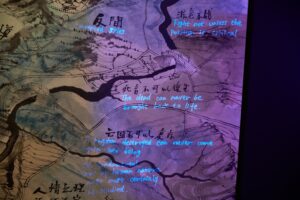Week1-Review of Tue&Thu’s seminar
Part I: Discuss the organization
At the beginning of the class, Dr. JL asked us to have a discussion about the gallery or the exhibition we visited. In our group, we selected some different organizations for exhibitions. Like the Scottish National Gallery, the Scottish National Gallery of Modern Art, and so on. I visited Talbot Rice Gallery last weekend, and to see the exhibition of Qiu Zhijie. A Chinese artist and curator, currently a Professor at the School of Transmedia Art, China Academy of Fine Art. Qiu Zhijie’s exhibition is on display in the white-domed exhibition hall of the Talbot Rice Gallery. In the art space on the second floor, Talbot Rice gallery exhibits his map of the art ecology, and personally, I would prefer their exhibition on the second floor, because when the format is small and dense, the light shining on the painting can make people’s attention more focused. In today’s seminar, as Dr. JL said, sometimes small is really beautiful, and I think about the organization of this exhibition. The lighting of the exhibition has been arranged from the psychological point of view of the audience, something that makes me equally consider the whole exhibition as a whole and its viewability. For the curators, it was a success in terms of lighting.



In this part, I think Qiu Zhijie’s exhibition should belong to the minor, because it is more like an inter-academic cooperation, or an exchange of works by artists from other countries.
Another exhibition I visited was at the National Gallery of Scotland on Impressionist paintings, Tasting Impressionism: Modern French Art from Millet to Matisse. Among them are Monet’s authentic works. Although there are no paintings as famous as the water lilies in Paris, there are many very well-known works on display. Monet’s gleaming poplars, the intense blooms of Van Gogh’s orchard, Gauguin’s frenetic Martinique, and more. I think this should be the ‘major’ exhibition that J.L. told us in class, because this exhibition is a symbol of regional culture to a certain extent. The exhibition explores how Scotland became an important place for Impressionism and Post-Impressionism. One of the art collections. The exhibition hall named after William Henry Playfair, an outstanding Scottish architect in the 19th century, is decorated with Impressionist colors, where the audience can see some dusty works of some artists during their growth, such as Degas’s portraits, blue Picasso in the color period. The collection of works of such prestige and quality in Scotland may be attributed to two opportunities – the progressive purchases of the directors of the Scottish National Gallery in the first half of the 20th century, and the generosity of the likes of Sir Alexander and Rosalind Maitland Donations, both reflect the enlightened state of Scottish artistic taste between the wars and after.
Monet, “Haystacks in the Snow”, 1891
Gauguin, The Vision After the Sermon, 1888
Part II: About the “set text” reading
I choose the chapter PiLi – Interview 2006, from p95-p103. Because as a Chinese, I am really concerned about Chinese contemporary art’s history and development. And I found that artist PiLi’s point is exactly what I identify with and try to spread.




Recent comments